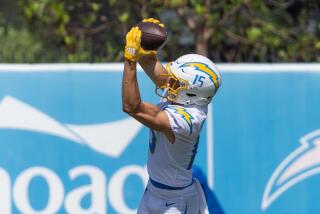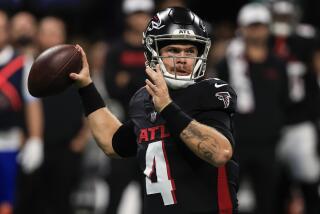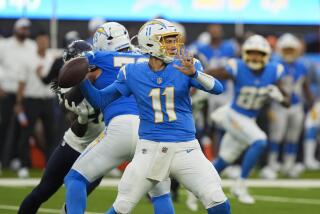NFL DRAFT ’87 : Chargers Trade for Banks, Draft to Build Defense
SAN DIEGO — Since he became head coach of the Chargers in the middle of last season, Al Saunders consistently has listed five priorities for strengthening the team: an outside linebacker, pass rusher, speed receiver, cornerback and dominant, every-down running back.
The Chargers addressed three of those needs in the first three rounds of Tuesday’s NFL draft. They traded for a proven linebacker in Chip Banks of Cleveland and took cornerback Louis Brock Jr. of USC in the second round and defensive end Karl Wilson of Louisiana State in the third.
The Chargers gave up their first- and second-round selections (fifth and 32nd) in exchange for Banks and the Browns’ first- and second-round picks (24th and 49th).
Surprisingly, the Chargers selected tight end Rod Bernstine of Texas A&M; in the first round. There had been no indication from owner Alex Spanos, director of operations Steve Ortmayer, scouting director Ron Nay or Saunders that a tight end was on the shopping list.
The Chargers took Iowa quarterback Mark Vlasic in the fourth round. Saunders had indicated he would like to find a young quarterback to observe Dan Fouts for a couple of years.
In the fifth round, the Chargers picked defensive back Nelson Jones of North Carolina State.
The Chargers basically got what they wanted in the opening rounds, but they weren’t able to avoid a few moments of confusion.
Saunders, for example, repeatedly referred to Chip Banks as Carl Banks, the name of the New York Giant linebacker. The Chargers probably wouldn’t have gone wrong with either Banks.
The Chargers had hoped to make a deal with the Indianapolis Colts for the second pick overall and take Alabama linebacker Cornelius Bennett. But the Colts made it known they weren’t going to deal. They selected Bennett for themselves.
Monday night, the Chargers reached a tentative agreement with the Browns to get Banks, contingent on the availability of linebacker Mike Junkin and/or linebacker Shane Conlan in the fifth spot of the first round.
Junkin and Conlan were still on the board after Indianapolis went for Bennett. Houston then selected Miami’s Alonzo Highsmith, Green Bay took Auburn’s Brent Fullwood and the Browns took Duke’s Junkin.
The Chargers had a strong interest in Fullwood, a running back who was viewed as a player capable of giving Saunders the more balanced attack he seems to want.
But it was a linebacker the Chargers wanted most, and they finally got, in Banks, a man they had been attempting to acquire for more than a year.
Brown General Manager Ernie Accorsi said, “We never shopped him or accepted overtures. If this trade had fallen through, we had no interest in trading him, but we wanted and needed Junkin. If I had a utopian situation, I would keep Chip and still be able to get Junkin. Chip is basically our best defensive player and he has never been a problem to us.”
The Chargers had begun pursuing Banks late last week after they concluded Bennett was out of reach.
“We asked our defensive staff to come up with every linebacker in the NFL comparable to Bennett,” Ortmayer said. “We had six players rated, with Banks No. 1.”
Asked if Banks was rated ahead of Giants linebacker Lawrence Taylor, Ortmayer said: “Yes.”
Banks, a USC product who has appeared in four of the last five Pro Bowls, is viewed by Saunders as a player who can improve the team’s pass rush and coverage.
“He is the best possible player to fill our needs,” Saunders said. “We are extremely excited. He is the most dominant linebacker in the NFL at the position we envision for him.”
Kevin Byrne, the Browns’ public relations director, said Banks’ pride was hurt when the team tried to trade him to Buffalo in 1985 as part of the transaction that enabled Cleveland to draft quarterback Bernie Kosar.
Banks refused to report to Buffalo, and the Browns had to substitute their No. 1 choice in the 1985 draft to complete the trade.
“He was very hurt at being traded,” Byrne said. “Our owner, Art Modell, met with him and explained that the Bills wanted our best player, which was Chip. He also explained that we considered quarterback more important than linebacker, but Chip still felt rejected and never got over his hurt.”
Byrne said he expected Banks to report to San Diego because the player had previously indicated a desire to return to Southern California.
Banks, who divides his off-season time between his home, Augusta, Ga., and Los Angeles, was unavailable for comment.
He did not report to the Browns’ spring mini-camps in 1985 and 1986 and was one of only half a dozen players who didn’t take part in the team’s off-season conditioning program in Cleveland, Byrne said.
“He didn’t make a commitment to Cleveland,” said Byrne, who estimated that 47 of 53 players on the roster lived in Cleveland in the off-season.
Cleveland Coach Marty Schottenheimer blamed Banks for what he called a lack of coordination in the team’s defense at the outset of the 1986 season. Banks, who was involved in a contract dispute, didn’t report to camp until five days before the season opener. However, he played well as the season progressed, and the Browns advanced to the AFC championship game.
There was little question that the Chargers had to improve their defense after they lost last year’s rookie sensation, Leslie O’Neal, who may miss the 1987 season with a knee injury.
The selection of Bernstine, however, came as a surprise. The Chargers are already deep at tight end, with Kellen Winslow, Eric Sievers and Pete Holohan. The selection indicates there is still some Air Coryell in the team’s future despite Saunders’ vow to institute more of a ball-control attack.
“It was a clear-cut but not an easy decision,” Ortmayer said. “We were in hopes of really strengthening our defense, but we felt Bernstine was far and away the best player available (at that point in the draft). We couldn’t pass him up.”
The Chargers used their full 15 minutes before settling on Bernstine--who led the Southwest Conference with 65 catches last year--as the 24th selection of the first round.
“He was the best player on the board, quite a ways above everybody,” Saunders said. “We went with the highest-rated player. We tried to trade down for an extra second-round pick, but we felt we could pick an adequate cornerback in the second or third round.”
Bernstine said he hadn’t heard from the Chargers before the draft and was very surprised to be taken by San Diego. He had expected to go to Cleveland.
The first contact he had with the Chargers was a phone call Tuesday morning from new receivers coach Charlie Joiner, informing him of his selection.
“I’ve grown up watching Kellen Winslow ,” Bernstine said, “and I’m sure he can teach me a lot. When he moves on, I hope I can fill his shoes.”
The Chargers’ second-round selection was more according to form.
Brock, son of Hall of Fame baseball player Lou Brock, had visited the Chargers recently and told Ortmayer he’d like to play in San Diego.
Brock denied reports that he has bad knees.
“I’ve had tendinitis since junior high, but Dr. J (Julius Erving) has it worse than me and has played 17 years of pro basketball,” he said.
Brock played baseball until his junior year at USC but quit to concentrate on football.
“We felt Lou and Eric Thomas of Tulane were the two best cover corners in the draft,” Saunders said.
Brock, who weighs only about 171 pounds, was the 11th defensive back selected.
Brock’s life will be a bit easier if Wilson, the Chargers’ third-round choice, is able to generate some heat on opposing quarterbacks.
“We think he is a top-quality pass rusher,” Saunders said. “He’s from a defensive-dominated school. Our defensive line coach, Gunther Cunningham, feels he has great pass rush ability.”
The Chargers gambled on Iowa’s Vlasic, the understudy to Chuck Long for three years before he inherited the starting job as a senior. A shoulder injury sidelined him nearly half of last season, but Saunders said there is no lingering medical problem.
Vlasic is unlikely to dislodge the incumbent No. 2 quarterback, Mark Herrmann, but he could put No. 3 Tom Flick out of work.
The Chargers last week looked at veteran free-agent Ron Jaworski, released earlier this year by Philadelphia. No decision on whether to sign Jaworski was due until after the draft, and the selection of Vlasic would appear to lessen Jaworski’s chances.
“Vlasic is an outstanding young quarterback who we think will mature in our system and compete for a job,” Saunders said.
Vlasic said his appearance in Iowa’s Holiday Bowl victory over San Diego State helped him.
“It helped me take care of some frustration (over being hurt) and showed the staff in San Diego what ability I have,” he said. He completed 15 of 28 passes for two touchdowns, but was sacked five times.
In taking Jones in the fifth round, the Chargers selected a larger and more physical player than their earlier cornerback selection, Brock.
CHARGER PICKS
Rnd., Player, Position, School 1. Rod Bernstine, TE, Texas A&M;
2. Louis Brock Jr., DB, USC
3. Karl Wilson, DE, LSU
4. Mark Vlasic, QB, Iowa
5. Nelson Jones, DB, N. Carolina St.
7. Jamie Holland, WR, Ohio State
8. Joe MacEsker, OT, Texas-El Paso
8. Ron Brown, LB, USC
9. Thomas Wilcher, RB, Michigan
10. A. Anderson, DB, Grambling
11. Joe Goebel, C, UCLA
12. Marcus Greenwood, RB, UCLA
The Chargers traded first- and second-round selections (fifth and 32nd) in exchange for Chip Banks and Browns’ first- and second-round picks (24th and 49th).
ON BANKS:
Quotable
‘He is the best possible player to fill our needs. . . . He is the most dominant linebacker in the NFL at the position we envision for him.’
--Coach Al Saunders
Notes
Chosen by the Browns as the third player overall in the 1982 draft.
Selected to the Pro Bowl 4 of the last 5 years.
Had 125 tackles, second on the Browns, last season.
Had 27 1/2 quarterback sacks in his career.


